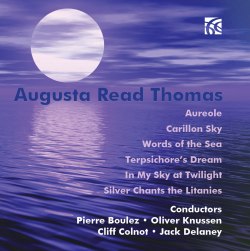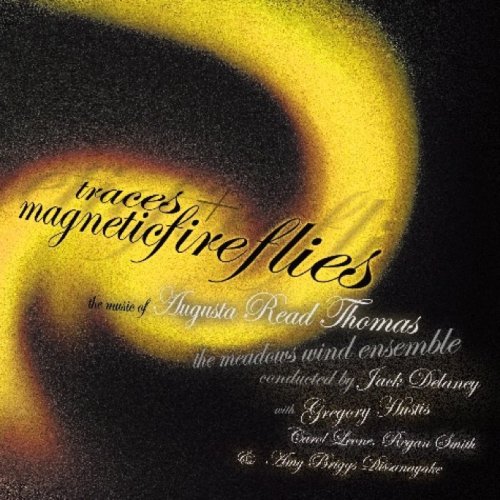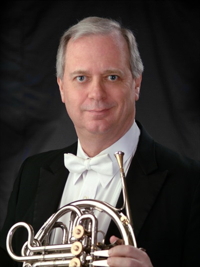Version #1: Solo Horn, Picc, 1/120/2200/2 Perc./2 Piano (celesta)/Harp/Str.11110
Premiered by the Southern Methodist University Wind Ensemble, Greg Huestis on horn, Jack Delaney conducting, Dallas, Texas, March 2004
Duration: 13 minutes
Version #2: Solo Horn, Picc, 1/120/2200/2 Perc./2 Piano (celesta)/Harp/ Str. (approx.)7.6.5.5.3
Premiered on a Portrait Concert at the Venice Biennale, Venice, Italy at the Teatro alle Tese in Venice. Ivan Fedele, Director of Music, 5 October 2018
Duration: 13 minutes
NOTE: The wind, brass, percussion, piano (celesta) harp parts are identical in both versions. The string parts are not identical.


This work is available on
AUGUSTA READ THOMAS - SELECTED WORKS FOR ORCHESTRA

This work is available on
TRACES AND MAGNETIC FIREFLIES.
Silver Chants the Litanies runs from 4:47-end

Silver Chants the Litanies, in memoriam Luciano Berio/Gustav Mahler, for solo French Horn and chamber orchestra was composed in 2003 and premiered on February 20, 2004 by the Meadows Wind Ensemble, at Southern Methodist University, Greg Hustis, Solo French Horn, conducted by Jack Delaney.
Music's eternal quality is its capacity for change, transformation and renewal.
At the time, my goal as well as the specifically commissioned-task for Silver Chants the Litanies was to compose music that "remembers and knows the repertoire" but also pushes forward in its own voice.
Berio was a hero of such "rememberings" in music and often his music remembered Mahler's music.
Silver Chants the Litanies was made as a memorial work directly after the death of Luciano Berio.
Having played trumpet for 13 years, I have a particular sensitivity about, and love for, the French Horn and was aiming to make a composition, which contains many contrasting sections, and which features many "colors and moods" of the instrument. The work lasts a brief 13-minutes and the materials evolve, transform, and shift characters from bold to majestic, to playful, to ritualistic, to elegant, to gentle, to resonant and echoing, and so forth. The soloist is always the leading light evoking orchestral conversations.
With music by Luciano Berio as one model, my music tries, here, to invent continuities — not to rupture and break from the past — and attempts to do so without being cliché, nostalgic or sappy. For instance, this music remembers what the flute meant to Debussy, what a major third has been in a universe of melodic and harmonic languages, what bells mean in current and past cultures, remembers forms and textures of Ravel, Varèse, and Bartok, remembers processes of narration and drama in opera. It remembers colors, and impulses of early Stravinsky, and the counterpoint of Bach, and the melodies of Mahler songs, and the horn calls of Mahler symphonies, and the inflection of Ella, and the invention of Coltrane, and so forth.
The pitches and harmonies are colorful and very carefully shaped over the course of the works' 13- minute duration. The rhythmic syntax is ever-changing, unpredictable, and vivid. Compound melodies, voice-leading, and quick shifts of mood, character and color abound. The score's markings are highly nuanced.
The title comes from this short poem by E. E. Cummings, which is used here with permission.
— Augusta Read Thomas

Text by E. E. Cummings
Stinging
stinging
gold swarms
upon the spires
silver
![]() chants the litanies the
chants the litanies the
great bells are ringing with rose
the lewd fat bells
 and a tall
and a tall
wind
is dragging
the
sea
with
dream
-S
To obtain examination or performance material for any of
Augusta Read Thomas's works, please contact G. Schirmer Inc..
